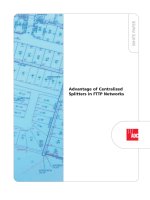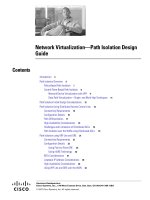aisc design guide 13 - errata - stiffening of wide-flange column at moment connections
Bạn đang xem bản rút gọn của tài liệu. Xem và tải ngay bản đầy đủ của tài liệu tại đây (338.11 KB, 2 trang )
Revision and Errata List, March 1, 2003
AISC Design Guide 13: Stiffening of Wide-Flange Columns
At Moment Connections: Wind and Seismic Applications
The following editorial corrections have been made in the
First Printing, 1999. To facilitate the incorporation of these
corrections, this booklet has been constructed using copies
of the revised pages, with corrections noted. The user may
find it convenient in some cases to hand-write a correction;
in others, a cut-and-paste approach may be more efficient.
4.4.2) and fillet-weld size. There is both a strength and
geometric relationship that must be satisfied. When the
bevel dimension and plate thickness are equal, as illus-
trated in Figure 4-13b, the minimum fillet-weld size to de-
velop the required effective throat in the web doubler plate
is:
When the bevel dimension is less than the plate thick-
ness, as illustrated in Figure 4-13c, the minimum fillet-
weld size to develop the required effective throat in the
web doubler plate is:
If a complete-joint-penetration groove weld is used, this
joint is generally not an AWS prequalified weld joint, but
can be successfully made with slight modification to the
following AWS prequalified weld joint designations:
(a) C-L1a or C-L1a-GF for web doubler plates that
meet the thickness limitation ( ) and
plate edges cut square
(b) TC-U4a (series) for plate thicknesses exceeding the
qualifications of (a) with beveled plate edges
The two primary deviations from the prequalified joints
are: (1) the root opening will exceed the maximum toler-
ance, assuming the plate width is selected to match the
T-dimension of the column; and, (2) the weld throat will
be slightly reduced, due to the flange-to-web fillet radius.
As with a fillet weld, however, allowing a slight encroach-
ment into the flange-to-web fillet radius reduces the shop
labor required to make the weld by reducing the volume to
be filled. The above practices are therefore recommended.
4.4.4 Connecting Web Doubler Plates Along the Top
and Bottom Edges
When transverse stiffeners are not used and the web doubler
plate is extended past the beam flange or flange plate as
recommended in Section 4.4.1, there is no force to transfer
32
between the top and bottom edges of the web doubler
plate and the column web. This is also the case when
transverse stiffeners are used and the web doubler plate
is extended past the transverse stiffeners as illustrated in
Figures 4-4 and 4-5. In these cases, a minimum-size fillet
weld per LRFD Specification Table J2.4 is used, except
that the minimum size need not exceed the web doubler
plate thickness minus
When transverse stiffeners are used and the web dou-
bler plate extends to (but not past) the transverse stiffener,
the joint between the transverse stiffener, column web and
web doubler plate must be detailed consistently with the
load path for the unbalanced force in the transverse stiff-
eners. Several common details are illustrated in Figures
4-11 and 4-12. The strength checks required for each of
these details are illustrated in Examples 6-13 and 6-14.
In Figures 4-11a and 4-12a, a CJP groove welded joint
detail is used at the top and bottom edges of the web dou-
bler plate(s). In Figures 4-11b and 4-12b, the joint details
are essentially the same, except a fillet weld is first made
connecting the transverse stiffener to the column web and
the remaining gap to the web doubler plate is subsequently
filled with weld metal. In each of these cases, the result-
ing joint can be used successfully on the thinner range of
web doubler plates, say up to thick. Beyond this
thickness it is advisable to bevel the edge of the plate.
Although this adds to the fabrication costs, it will benefit
the welder and increase the probability of making a sound
weld. In each of the details illustrated in Figures 4-11a,
4-11b, 4-12a, and 4-12b, one-quarter of the unbalanced
force in the transverse stiffeners is transferred at each
weld.
In Figure 4-11c, a CJP groove weld is used to connect
one transverse stiffener to the column web. The web dou-
bler plate extends to contact the transverse stiffener and
is fillet welded to it. In Figure 4-12c, a similar detail is
used with web doubler plates on both sides of the column
web. If the column web thickness is sufficient to trans-
mit the full unbalanced force from the transverse stiffen-
ers (Equations 4.4-2 and 4.4-3 can be used for this check),
the fillet weld between the transverse stiffener and the web
doubler plate is selected as a minimum-size fillet weld per
LRFD Specification Table J2.4. Otherwise, the joint de-
tail must be configured to transmit the portion of the un-
balanced force in excess of the column web strength to the
web doubler plate.
In Figure 4-11d, the fillet welds on the right side connect
one side of the transverse stiffener to the column web and
the other side to the web doubler plate. In Figure 4-12d, a
similar detail is used with web doubler plates on both sides
of the column web. In each of these details, one-quarter of
the unbalanced force in the transverse stiffeners is trans-
ferred at each weld.
(4.4-7)
(4.4-8)
where
web doubler plate specified minimum yield
strength, ksi
minimum web doubler plate thickness re-
quired for strength per Equation 4.4-1, in.
welding electrode specified minimum
strength, ksi
Rev.
3/1/03
( 2 )









